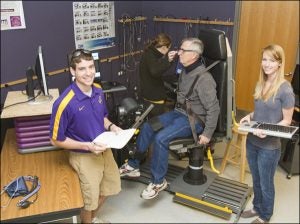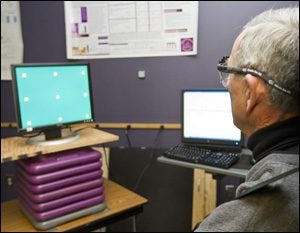HEALTHY AGING
ECU study examines relationship between vision and muscle steadiness with age

ECU students Luke Spangler, left, and Katie Reynolds, right, record data while Becky Krupenevich, an ECU graduate student, adjusts equipment that will help the students measure visual steadiness and muscle coordination. ECU alumnus John Hart is the study participant (Photo by Chuck Baldwin, College of Health and Human Performance)
One out of every three adults aged 65 and older will fall this year, according to the Centers for Disease Control and Prevention.
Of those seniors who fall, 20 to 30 percent will suffer injuries that will shorten their life span or negatively affect their quality of life.
East Carolina University researchers are working to improve those statistics through a project under way in the College of Health and Human Performance. Senior ECU exercise physiology majors Luke Spangler and Katie Reynolds are investigating the relationship between muscle coordination and visual steadiness, thanks to funding through ECU Undergraduate Research and Creativity Activity Award.
“Understanding the relationship between the steadiness of our vision and the steadiness of our muscles can lead to an improved quality of life as we age,” said ECU kinesiology professor Dr. Paul DeVita, one of two faculty mentors who are overseeing this research. Dr. Nick Murray is also serving as a faculty mentor and Becky Krupenevich is a graduate student assisting with this project.
DeVita used the example of walking up a flight of stairs, which requires clear vision to see how high each step is, along with adequate muscle force to actually make the step. When vision fails, a person may not perceive the step’s height accurately and may therefore trip and fall.
“We use our vision to tell our muscles what to do,” said Spangler. Walking up the stairs, stepping off a curb and pouring a glass of water are daily activities that require precise movements, he said. Muscle force control is very often mediated through our visual information.
Muscles for research
Retired U.S. Army Lt. Col. John Hart, ’62 ECU graduate is one of 20 health seniors who are participating in the study. Hart has jogged 23,000 miles in 35 years. At the age of 72, he is still running a two-mile run six days a week.
Now he’s added to his regimen by applying his muscles for research in the ECU biomechanics lab in ECU’s Department of Kinesiology. There Hart is secured into an isokinetic dynamometer, an instrument connected to his leg that measures muscle force while he is sitting in a large chair.
He is fitted with a special pair of glasses with a camera that tracks the position, and movement of his pupils.
Hart begins the test with three vision only tasks. He simply follows with his eyes a moving target along three templates. The templates include a horizontal line, a line that increases and decreases and a curvilinear line that also rises and falls on the computer screen. As he moves his eyes, the glasses track the position of his pupils as they follow the target and his vision steadiness is derived from these data.
visionforce1
ECU research participant John Hart focuses on computer screen template while special glasses gather data for a study investigating the relationship between muscle strength and visual steadiness.

ECU research participant John Hart focuses on computer screen template while special glasses gather data for a study investigating the relationship between muscle strength and visual steadiness.
Hart’s next goal today is to control a visual target along the same three templates by modulating his thigh muscle force. “Steady she goes,” said Hart as he extended his right knee against a stationary bar to move the ball across the horizontal line on the screen.
Data collected from the vision and muscle force tests will help researchers link the leading interaction of vision and muscle force steadiness as we age. Spangler, Reynolds, and Krupenevich expect that people with better visual control will also have better muscle force control. If this is the case, the next step would be to see if improved visual function through vision-training leads to improve muscle function.
The study also includes a group of 20 volunteers between the ages of 18-22. Subjects in this age group provide data that will show the effect of age on vision and muscle force steadiness.
This study is also part of the major research line in the biomechanics laboratory, neuromuscular adaptations in healthy human aging. DeVita and former lab mentor, Dr. Tibor Hortobagyi, investigate a variety of activities of daily living in older adults and how training can improve the performance of these activities.
Training Researchers Early
Luke Spangler and Katie Reynolds competed for the award, which allowed them to conduct this study. The University Research and Creative Activity awards provide funds that support faculty-mentored research or creative projects undertaken by undergraduate students.
“The increased support for undergraduate research has been a great help in offering the opportunity for more undergraduate students to become involved in research,” said Dr. Glen Gilbert, dean of the College of Health and Human Performance.
“ECU has shown a commitment to Undergraduate Research as a value-added experience across university programs,” said Dr. Mary Farwell, director of Undergraduate Research.
“Undergraduate research provides a gateway to graduate and/or professional studies, in addition to preparing students for the workforce by augmenting learning from the normally scheduled courses and laboratories,” she continued.
“Conducting research as an undergraduate student has opened my eyes to the other side of academics,” said Reynolds. “It has been a stimulating change from the usual chair and desk in the classroom,” she continued.
Reynolds is a double major Hispanic Studies from Raleigh. She plans to work for a year as an EMT or medical translator while applying to medical schools. She hopes to pursue a career as a physician in family or internal medicine.
Spangler, from Winston-Salem, will graduate in May. He also plans to continue his education in medical school.
Making a Difference
The research in the biomechanics laboratory along with other research conducted throughout the Department of Kinesiology makes a difference to our society in two fundamental ways.
“Much of the research increases our knowledge of basic biological processes such as neural control of muscle force, metabolic pathways in health and pathological states, and psychological processes involved with physical activity,” said DeVita.
These research studies also provide readily usable information and procedures for improving the quality of our daily lives. Faculty members, graduate and undergraduate students throughout the department have identified appropriate exercise and physical activity lifestyles that enhance human health and improve human performance. The aging related work in the biomechanics laboratory for example has provided the bases for exercise programs that maintain and improve walking abilities in older adults.
“It is hoped that the present vision-muscle force investigation leads to improved control of muscle forces during walking, ascending and descending stairs, driving cars, and holding objects in our hands,” said DeVita.